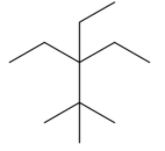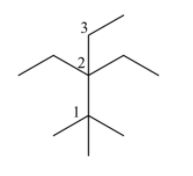
What will be the molecular formula of the bond line structure? And how?


Answer
481.2k+ views
3 likes
Hint: The concept of bond line formulas is to be used in this question. In the given compound, there are carbons that have methyl and ethyl groups attached to the sides and these contribute to increasing the molar mass of the compound.
Complete step by step answer:
In order to answer our question, we need to learn about the bond line formula for organic compounds. Now, carbon has a valency of 4. That means, one carbon can attach with itself 4 other groups or atoms, so that it’s octet gets filled. This results in the cast range of compounds in the field of organic chemistry. Now, due to the excessive number of compounds, there are some compounds which are very complex or large and it is very time consuming to draw structures of them. Moreover, they will look very messy on paper. So, bond line formulas are preferred. Bond line structures are very simple to draw and understand the structure of very large compounds of organic chemistry. These days, the two dimensional formulae of the organic compounds are also shown with the help of bond line notations in which the bonds are shown with the help of lines only. For example, a single line (-) represents a single C to C bond ; a double line (=) indicates a double C to C bond while a C to C triple bond is shown by a triple line (

Here the four terminal lines represent the methyl groups. Each and every ‘edge’ represents a carbon atom. Similarly in this way, we can represent other complex carbon compounds. Now, let us come to our question. We have been given the compound :

Now, let us name it from carbon 1 to carbon 3. There are 3 methyl groups attached in carbon 1, 2 ethyl groups present in carbon 2 and 1 methyl group in carbon 3. So the molecular formula will be:
Note: It is to be noted that the bond line formula is for drawing 2D organic structures. It doesn't give us any idea about whether the bond is directed inside the plane or outside the plane. However, bond line formulas can give us an idea about steric hindrance.
Complete step by step answer:
In order to answer our question, we need to learn about the bond line formula for organic compounds. Now, carbon has a valency of 4. That means, one carbon can attach with itself 4 other groups or atoms, so that it’s octet gets filled. This results in the cast range of compounds in the field of organic chemistry. Now, due to the excessive number of compounds, there are some compounds which are very complex or large and it is very time consuming to draw structures of them. Moreover, they will look very messy on paper. So, bond line formulas are preferred. Bond line structures are very simple to draw and understand the structure of very large compounds of organic chemistry. These days, the two dimensional formulae of the organic compounds are also shown with the help of bond line notations in which the bonds are shown with the help of lines only. For example, a single line (-) represents a single C to C bond ; a double line (=) indicates a double C to C bond while a C to C triple bond is shown by a triple line (

Here the four terminal lines represent the methyl groups. Each and every ‘edge’ represents a carbon atom. Similarly in this way, we can represent other complex carbon compounds. Now, let us come to our question. We have been given the compound :

Now, let us name it from carbon 1 to carbon 3. There are 3 methyl groups attached in carbon 1, 2 ethyl groups present in carbon 2 and 1 methyl group in carbon 3. So the molecular formula will be:
Note: It is to be noted that the bond line formula is for drawing 2D organic structures. It doesn't give us any idea about whether the bond is directed inside the plane or outside the plane. However, bond line formulas can give us an idea about steric hindrance.
Latest Vedantu courses for you
Grade 6 | CBSE | SCHOOL | English
Vedantu 6 Pro Course (2025-26)
School Full course for CBSE students
₹45,300 per year
Recently Updated Pages
Master Class 9 General Knowledge: Engaging Questions & Answers for Success

Master Class 9 English: Engaging Questions & Answers for Success

Master Class 9 Science: Engaging Questions & Answers for Success

Master Class 9 Social Science: Engaging Questions & Answers for Success

Master Class 9 Maths: Engaging Questions & Answers for Success

Class 9 Question and Answer - Your Ultimate Solutions Guide

Trending doubts
State and prove Bernoullis theorem class 11 physics CBSE

What are Quantum numbers Explain the quantum number class 11 chemistry CBSE

Who built the Grand Trunk Road AChandragupta Maurya class 11 social science CBSE

1 ton equals to A 100 kg B 1000 kg C 10 kg D 10000 class 11 physics CBSE

State the laws of reflection of light

One Metric ton is equal to kg A 10000 B 1000 C 100 class 11 physics CBSE




